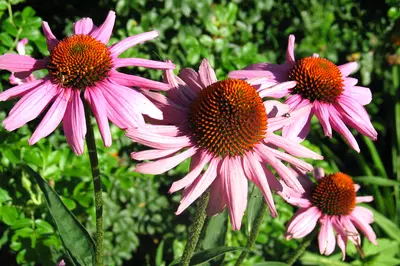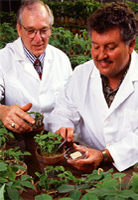Botanical Medicine

How Long Have Humans Used Botanicals?
It is likely that humans have used plants as medicine for as long as we have existed. Archeological excavations dated as early as 60,000 years ago have found remains of medicinal plants, such as opium poppies, ephedra, and cannabis.
Since the beginning, humans have experimented with plants to learn how they can help us heal. In essence, humans have been involved for thousands of years in a vast "clinical trial" with medicinal plants. The wisdom that resulted from this global experiment is a large part of our history of healing and healthcare.
How we learned about plants
 It's possible that our ideas about the curative powers of plants came from observing animals use plants.
It's possible that our ideas about the curative powers of plants came from observing animals use plants.
In many early cultures, knowledge of a plant's curative properties came through the practice of Shamanism, which is a kind of spirit medicine still practiced in many parts of the world. Some Shamans communicate with certain plants ("plant teachers") to access knowledge about other plants and healing techniques.
There seems to be an intuitive connection between humans and plants that enables some sensitive individuals, under special circumstances, to tune in to the healing potential residing in plants.
What are the first written records?
As the knowledge from Shamanism and other practical experimentation grew, herbalists began to catalog their knowledge of medicinal plants.
One of the oldest written records on medicinal plants, dated 1500 B.C., is the Egyptian Ebers Papyrus. In India, the Charaka Samhita, dated 700 B.C., documented the uses of more than 300 medicinal plants.
Are plants healers or non-living compounds?
Throughout much of history, humans believed that the "vital spirit" of the plant contributed to its therapeutic effect. But in the early 1800s, scientists isolated morphine from opium, which led to the belief (in the West at least) that a single, non-living compound in a plant was responsible for its healing properties.
This, in turn, helped create the biomedical model of pharmacotherapy that still remains in medicine today. In this model, plants are seen simply as the source of a single chemical that targets a single receptor site or other part of the body and fixes the individual's health problem, much as a mechanic might use a wrench to fix an automobile.
This "machine" model of living systems can be useful, but it is clearly inadequate to explain the complexity of the human system. Humans display properties that are not reducible to the component parts, unlike parts of a machine. Likewise, the healing effects of plants cannot always be reduced to a single element.
Are plants used in pharmaceuticals today?
 Eventually most scientists believed that there was no need to use plants themselves in drugs because chemists could synthesize compounds that were more potent (and often more toxic) than the natural products offered by nature. Now, most pharmaceuticals are synthetic compounds.
Eventually most scientists believed that there was no need to use plants themselves in drugs because chemists could synthesize compounds that were more potent (and often more toxic) than the natural products offered by nature. Now, most pharmaceuticals are synthetic compounds.
But note that the structure of synthetic pharmaceuticals often resembles natural molecules. And as prominent botantical researcher Joanne Raskin noted in her 2002 study, 11 percent of the 252 drugs considered essential by the World Health Organization are exclusively derived from flowering plants.
What were the political, economic, and scientific impacts?
Viewing plant medicines as simply sources of chemical compounds instead of vital spirits had profound political, economic, and scientific impacts.
Once the therapeutic effects of plants were attributed to inert chemicals, certain medical practitioners, who increasingly wanted to portray their profession as a rational and scientific endeavor, sought to distance themselves from the "superstitious" and intuitive practices of herbalists and other traditional healers. In the United States, the teaching of herbalism in the curricula of medical schools was prohibited and whole schools were closed in the 1930s. One of the casualties was the University of Minnesota's school of homeopathic medicine, which was closed as a result of these reforms.
Wasn't there a swing back to holism?
The 1990s witnessed a swing back toward a more holistic perspective in medicine, with less reliance on potent drugs that often have serious side effects. This change contributed to a renewed interest in botanical medicines that generally have fewer risks than pharmaceutical drugs.
In 1994, in response to overwhelming public demand, the federal government passed the Dietary Supplement Health and Education Act (DSHEA). DSHEA allowed botanical medicines to be sold as "dietary supplements" as long as the manufacturers didn't make any health claims. (Note that this provision can be somewhat confusing and puts the burden on consumers to research the dietary supplements themselves.)
In 2007, the Federal Drug Administration (FDA) announced a final rule establishing current good manufacturing practice requirements for dietary supplements. The final rule requires manufacturers to report all adverse events to the FDA, as well as evaluate the identity, purity, quality, strength, and composition of its dietary supplements. This change places more accountability on the industry and should increase consumers' confidence in the quality of dietary supplements, according to the FDA.
The role of botanicals in healthcare today
Between 1990 and 1997, the use of botanical medicines increased by 380 percent in the United States. By 2010, the global retail sale of botanical dietary supplements amounted to more than $25 billion, according to Nutraceuticals World. Outside the United States, the World Health Organization reports that 75 to 85 percent of the world's population continues to rely on botanical medicines dispensed by traditional healers for primary healthcare, as they have always done.
Scientists have renewed efforts to study botanicals, resulting in increasing scientific evidence for the safety and efficacy of many botanical medicines, especially for chronic diseases and health maintenance. In addition, schools of pharmacy and medicine have revived courses in science-based herbalism and pharmacognosy. Schools of naturopathic and holistic medicine, such as Bastyr University in Seattle, are becoming more popular.
The increasing acceptance of botanical medicines seems likely to continue, for generally good reasons. If botanical medicines are used judiciously, based on good scientific evidence and sound therapeutic practice, then they can and should have a place in modern medicine.
Blumenthal, M., Grant, K.L., Caveliere, C. (2006). Total sales of herbal supplements in U.S. show steady growth. Herbalgram, 71, 64-66. Retrieved Feb. 25, 2008, from http://content.herbalgram.org/abc/herbalgram/articleview.asp?a=3012.
Engel, G.L. (1992). How much longer must medicine's science be bound by a seventeenth century world view? Psychother Psychosom, 57(1-2), 3-16.
Final rule promotes safe use of dietary supplements - FDA consumer health info. (2007). Retrieved Jan. 16, 2008, from http://www.fda.gov/consumer/updates/dietarysupps062207.html.
Goldman, P. (2001). Herbal medicines today and the roots of modern pharmacology. Ann Intern Med., 135(8 Pt 1), 594-600.
Halberstein, R.A. (2005). Medicinal plants: Historical and cross-cultural usage patterns. Ann Epidemiol., 15(9), 686-699.
Morris, C.A. (2003). Internet marketing of herbal products. JAMA, 290, 1505-1509.
Raskin, I., et al (2002). Plants and human health in the twenty-first century. Trends in Biotechnology, 20, 522-531.
Traditional medicine (2003). Retrieved Feb. 26, 2008, from http://www.who.int/mediacentre/factsheets/fs134/en/index.html.

